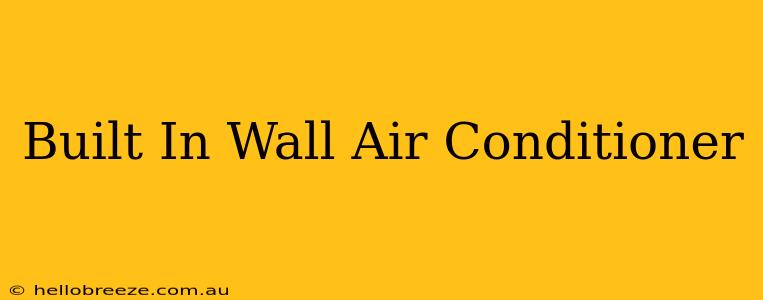Are you looking to beat the heat without sacrificing your home's aesthetic? Built-in wall air conditioners offer a stylish and efficient cooling solution that seamlessly integrates into your interior design. Unlike traditional window units, these systems are discreetly installed within your wall, providing powerful cooling without the bulky, unsightly appearance. This comprehensive guide will explore the benefits, considerations, and installation process of built-in wall air conditioners, helping you make an informed decision for your home.
Benefits of Built-In Wall Air Conditioners
-
Sleek and Discreet Design: The most significant advantage is their unobtrusive design. They blend seamlessly with your wall, maintaining a clean and uncluttered look. No more bulky units dominating your windows or taking up valuable floor space.
-
Improved Energy Efficiency: Many models boast high energy efficiency ratings (SEER), meaning they consume less energy to produce the same level of cooling compared to older or less efficient units. This translates to lower energy bills and a smaller carbon footprint.
-
Enhanced Home Security: Unlike window units, built-in AC units don't compromise your home's security by providing easy access points.
-
Quiet Operation: Modern built-in units are engineered for quieter operation, providing cool comfort without disruptive noise.
-
Versatile Placement: While typically installed in walls, some models allow for flexible placement, providing greater design freedom.
Factors to Consider Before Installation
Before purchasing and installing a built-in wall air conditioner, carefully consider these crucial factors:
-
Room Size: Accurate calculation of your room's square footage is essential to select a unit with the appropriate cooling capacity (BTUs). An undersized unit will struggle to cool the room effectively, while an oversized unit may cycle on and off frequently, wasting energy.
-
Professional Installation: Installing a built-in wall air conditioner is a complex process that requires expertise. Improper installation can lead to reduced efficiency, leaks, and safety hazards. Always hire a qualified HVAC professional.
-
Wall Construction: The type of wall construction will impact the installation process. Certain wall materials might require additional work or specialized tools.
-
Electrical Requirements: Ensure your home's electrical system can handle the unit's power requirements. Upgrading your electrical panel might be necessary in some cases.
-
Budget: Built-in wall units generally have a higher upfront cost compared to window units. However, the long-term energy savings and enhanced aesthetics can justify the investment.
Choosing the Right Built-In Wall Air Conditioner
The market offers a range of built-in wall air conditioners varying in features, size, and price. Key factors to consider when selecting a unit include:
-
BTU Rating: This indicates the unit's cooling capacity. Choose a unit with the appropriate BTU rating based on your room's size.
-
SEER Rating: This measures the unit's energy efficiency. A higher SEER rating translates to lower energy consumption.
-
Noise Level: Look for units with low noise levels for a more peaceful environment.
-
Smart Features: Some models offer smart features such as Wi-Fi connectivity, allowing you to control the unit remotely using a smartphone app.
Installation Process: A General Overview (Professional Installation is Recommended)
While a detailed installation process is best left to qualified professionals, a general overview includes:
-
Cutting the Wall Opening: Precisely cutting the opening in the wall to accommodate the unit is crucial.
-
Installing the Indoor and Outdoor Units: Connecting the indoor and outdoor units involves intricate refrigerant lines and electrical wiring.
-
Securing the Unit: Properly securing the unit within the wall is vital for its stability and longevity.
-
Connecting to Electrical and Ductwork: Connecting the unit to the home's electrical system and any existing ductwork is crucial for efficient operation.
-
Testing and Commissioning: After installation, the unit is thoroughly tested to ensure proper functionality and leak-free operation.
Maintaining Your Built-In Wall Air Conditioner
Regular maintenance is crucial for optimal performance and longevity. This includes:
-
Cleaning the filters regularly: Clogged filters restrict airflow, reducing efficiency and potentially damaging the unit.
-
Checking refrigerant levels periodically: Low refrigerant levels can significantly impact cooling performance. Consult a professional for refrigerant checks.
-
Annual professional maintenance: An annual inspection by a qualified technician will identify potential problems before they escalate into costly repairs.
By carefully considering the factors discussed above and opting for professional installation, you can enjoy the benefits of a stylish, efficient, and discreet built-in wall air conditioner for years to come. Remember, a cool home is a happy home!

